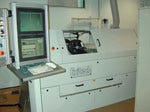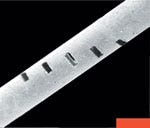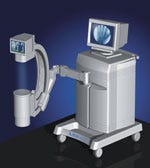Laser Drills Critical Holes in Blood-Gas Sensor
April 5, 2001
Originally Published MPMN April 2001
PROFILE
Laser Drills Critical Holes in Blood-Gas Sensor
Micromachining technology enables effective processing of acrylic optical fibers.
A multiparameter blood-gas monitor system combines fiber optics with specific chemical probes to directly measure blood chemistry and blood gases. The key component in the instrument is a small invasive probe fitted with three optical-fiber sensors that simultaneously measure CO2, O2, and pH and a conventional thermocouple for temperature measurement. The sensors are fabricated from acrylic optical fiber measuring 175 µm in diameter. A primary challenge faced by Diametrics Ltd. (High Wycombe, Bucks, UK), which developed the system, was to find a way to repeatably drill consistently sized holes in the fiber. The firm settled on an excimer laser that was able to perform the exacting task without straining the production budget. The blood-gas monitor is marketed by Agilent Technologies and Johnson & Johnson."The probe had to be as small as possible to minimize insertion trauma, and maintain existing monitoring modes," according to Diametrics operations engineering manager Malcolm Jones. "It also had to be fabricated from biocompatible polymers that could withstand at least one cycle of sterilization." The plastics had to have suitable physical properties to support the micromachining of small holes and encapsulation of appropriate chemistries, he adds, and lastly, manufacturing costs had to remain low to meet market conditions for the disposable device. Preventing Thermal DamageDuring operation, light from an LED source is launched into the probe from a control unit and then reflected by a small stainless-steel mirror encapsulated in the end of each optical fiber. The light passes through a series of transverse holes drilled into the fibers in a helical formation. Light passing along the fibers interacts with the chemistry in the holes before returning to the control unit, where the return light intensity is measured. The laser micromachining workstation developed by Exitech features an excimer laser with a 193-nm-wavelength beam. The image on the left shows the five-hole sequence created by the excimer laser.
The laser micromachining workstation developed by Exitech features an excimer laser with a 193-nm-wavelength beam. The image on the left shows the five-hole sequence created by the excimer laser.
Micromachining the small holes represents a critical step in the manufacturing process because the hole dimensions must be consistent to provide repeatability. Diametrics originally subcontracted the task to Exitech Inc. (Menlo Park, CA), a company that offers turnkey laser workstations and a range of laser processing services.
After testing, Exitech determined that an argon fluoride excimer laser was the best choice for machining acrylic fibers. Due to increased sales, Diametrics recently brought the job in-house, using a laser micromachining workstation supplied by Exitech. The laser outputs at a wavelength of 193 nm, in the deep UV range. "This is a perfect task for micromachining with an ultraviolet laser," says Exitech president Dafydd Thomas. "Ultraviolet light can be focused to much smaller beam dimensions than visible or infrared light," he says. "Ultraviolet light ablates polymers by directly vaporizing the material in a cold process, and it does not cause thermal damage to surrounding material," adds Thomas.
|
100µm |
To form the holes, a spool of optical fiber is loaded into the workstation that automatically feeds a 1-m-long piece of fiber to the laser drilling head. Mechanical tension and a vacuum chuck rigidly hold the fiber. The laser beam is split using a set of mirrors so that all five holes can be drilled simultaneously without moving or rotating the fiber. This streamlines the process and ensures the holes' identical dimensions: each one has a rectangular shape with a 100 x 50-µm cross section that tapers to about 50% at the opposite side of the fiber. After drilling, a new section of fiber is automatically cut by means of a metal blade and stacked for further processing.
Machining Multiple Parts
Excimer lasers have been in use in industrial settings since the 1980s. They emit photons in the UV region without frequency conversion. Because of the incoherent and highly divergent nature of the beam, excimer lasers are suitable for multiple, simultaneous feature machining; splitting the main beam enables multiple part processing.
While excimer lasers can be configured to produce 308-, 248-, or 193-nm wavelengths, the most popular models are in the 248-nm range and use a combination of krypton and fluorine. They are highly reliable and can be used to machine most plastics. The 193-nm laser used by Diametrics is more expensive to operate, but its manufacturer claims it is the only laser of its kind that can directly break the strong chemical bonds of biocompatible materials such as Teflon and acrylic fibers. "In this case, laser micromachining is truly an enabling technology," notes Jones. "This task simply could not be performed by any other means."
Katherine Sweeny
X-ray Manufacturer Gets the Lead Out
Replacing lead with a thermoplastic-metal composite cuts costs, improves workplace safety.
Nobody likes lead and everybody would rather do without it. Xitec (East Windsor, CT), a manufacturer of x-ray fluoroscopy systems, had been using the heavy metal in its x-ray tube shield, a cylindrical part that helps to concentrate x-rays and to shield personnel from stray radiation. But safety issues and the costs involved with the use of this hazardous metal led them to search for an alternative material.
The costs and the effort involved in manufacturing the lead tube shield were continually increasing. Not only were materials suppliers passing along the rising cost of more-stringent regulatory controls, but Xitec had to beef up its safety controls and training for assembly and soldering procedures. Furthermore, the shield and especially a precision aperture at one end were prone to damage when the soft, malleable lead was handled prior to final assembly. Scrap was also a constant headache.
|
By using a thermoplastic metal composite instead of conventional lead, Xitec was able to reduce by 50% the overall production costs of x-ray tube shields. |
In his search for an alternative material, Xitec chairman Dave Malcom heard about the EcoMass thermoplastic metal composite from PolyOne (Cleveland). The material is part of a new family of high-density composites that can be used as nonhazardous alternatives to lead and other high-gravity metallic materials in many applications.
Randy LaValley, Xitec's mechanical design engineer, followed up with Robert Durkee of Ideas to Market (Austin, TX), a technology-transfer firm that brought EcoMass to market and owns the patent. LaValley and Durkee worked together to develop a shield that could be manufactured using conventional thermoplastic molding equipment.
"Robert Durkee helped us by designing and commissioning the molds for the part," says LaValley. "EcoMass composite has turned out to be the perfect answer to our needs." A mounting ring is molded into the part, removing several processes from assembly. "Best of all," says LaValley, "the radiation performance of the EcoMass material is excellent—zero rad meter at 16 in."
LaValley says that when all the costs of the material and its molding and production are considered, it saves the company 50% over the cost of using lead. "It took us less than half a year to switch from lead to EcoMass. That's six months for a total switch in material and approach, including part design, mold production, assembly training, everything."
The EcoMass composite incorporates tungsten, the heaviest of metals, as a filler. Xitec specified EcoMass NJ-96 TP, which has a specific gravity of 11 g/cm, equivalent to lead.
Consisting of powdered tungsten dispersed in a thermoplastic matrix, EcoMass provides radiation shielding and high-mass characteristics comparable to lead. The material combines tungsten's density and inertness, while exhibiting high yield strength and providing the processing benefits of a conventional thermoplastic material. The scrap from these composites is 100% recyclable at the molder and retains its properties through regrind and multiple heat histories.
EcoMass and other polymer-metal composites can be formulated using a variety of thermoplastic binders and filler compositions to tailor a product's density, heat-deflection temperature, tensile strength, impact strength, and flexural modulus, all to specific customer requirements. Currently, eight compounds are available, ranging in specific gravity from 6.0 to 11.0 g/cm.
The x-ray tube shield is now being used in Xitec's portable c-arm x-ray equipment, which is used in the medical and veterinary markets to view extremities and for podiatry and hand surgery.
Copyright ©2001 Medical Product Manufacturing News
You May Also Like


.png?width=300&auto=webp&quality=80&disable=upscale)

